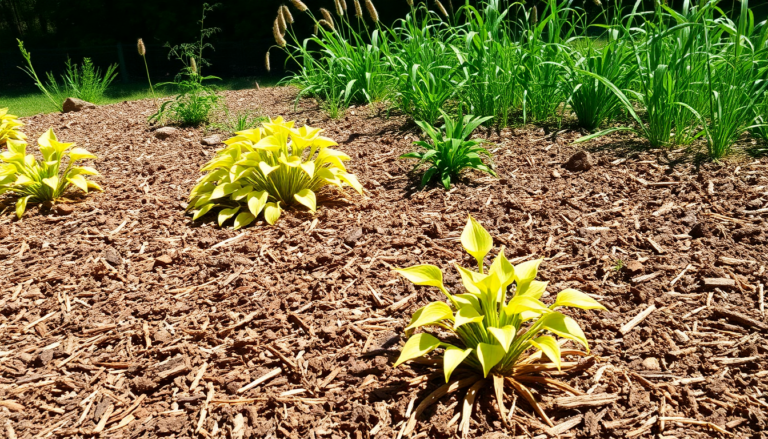Argomenti trattati
- Understanding the importance of mulch in gardening
- Misusing rock mulch
- Careful with mulch over seeds and young plants
- Steering clear of rubber mulch
- Volcano mulching: a common misconception
- The dangers of cocoa mulch
- Understanding mulch thickness
- Timing and temperature: when to mulch
- Avoiding artificial mulch colors
Understanding the importance of mulch in gardening
Mulch serves a crucial role in gardening, offering insulation for newly-planted perennials and shrubs during chilly winters and keeping roots cool during scorching summers. Its ability to conserve moisture means you’ll find yourself watering less often, while it simultaneously suppresses pesky weeds that threaten your garden beds. Organic mulches—composed of materials like bark, shredded wood, and pine straw—are especially beneficial as they decompose over time, enriching your soil with essential nutrients.
However, utilizing mulch isn’t as straightforward as it may seem. Applying it incorrectly can lead to various issues, from drainage complications to overheating plant roots. It’s vital to choose the right type of mulch and apply it properly to maximize its benefits. To help you achieve the best results, we consulted horticultural experts to highlight common mulching mistakes that many gardeners tend to make.
Misusing rock mulch
One prevalent error is opting for rock mulch, which may seem appealing for its low-maintenance reputation. However, Stacey Hirvela, a horticulturalist, warns that rock mulches can be problematic. While they are durable and long-lasting, they often shift out of place, creating hazards in your lawn and walkways. Rock mulch does little to benefit plant health; in fact, it can increase temperatures around sensitive plants like hydrangeas and lilacs.
Moreover, when combined with landscape fabric, rock mulch can lead to serious drainage issues. This combination restricts gas exchange in the soil, trapping carbon dioxide and creating an inhospitable environment for root development. In dry climates, rock mulch may be suitable due to the adaptability of local desert plants, but in most settings, it’s best to opt for organic alternatives.
Careful with mulch over seeds and young plants
When mulching in vegetable gardens, extra caution is required. While mulching established transplants can be beneficial, it’s crucial to avoid covering newly planted seeds or germinating plants. Gary Pilarchik, an expert in edible gardening, emphasizes that mulch can suffocate young plants. He recommends waiting until your seedlings reach at least two inches in height before applying mulch, ensuring it’s carefully placed around the stems using materials like straw, compost, or shredded hardwood.
Steering clear of rubber mulch
Rubber mulch may seem like a low-maintenance solution, but its drawbacks are significant. Although it won’t break down, it does nothing to enrich your soil. According to Hirvela, rubber mulch should only be used in play areas, not in plant beds. Its non-decomposing nature can lead to pollution in your soil with unknown chemicals. Furthermore, rubber mulch tends to migrate out of designated areas, becoming a nuisance.
Volcano mulching: a common misconception
Ignoring the trendy practice of volcano mulching around trees is essential. This method involves piling mulch high around the base of the trunk, which can lead to moisture accumulation that promotes rot, disease, and pest infestations. Kat Aul Cervoni, a landscape designer, recommends using a donut shape for mulch placement, tapering it away from the trunk to allow for proper moisture and air circulation.
The dangers of cocoa mulch
Cocoa mulch, known for its pleasant scent, poses a significant risk to pets. Although it is organic, it contains theobromine, which is toxic to dogs. Ingesting cocoa mulch can lead to serious health issues, including vomiting and seizures. If you have pets, consider safer organic options that won’t harm your furry friends.
Understanding mulch thickness
Applying mulch too thickly can be detrimental to your garden’s health. Organic mulches, such as shredded bark, often repel water due to their natural wax content. While a light layer of 2 to 3 inches allows for adequate water penetration, overly thick layers can suffocate the soil and limit oxygen exchange. If you notice water pooling or running off your mulch, it might be time to remove some of it or fluff it up to encourage airflow and decomposition.
Timing and temperature: when to mulch
Timing is everything in gardening. Avoid mulching during hot, humid conditions, especially when working near tender, new plant growth. Fresh mulch can damage delicate shoots, so ensure you feather it out as it approaches the plants to prevent direct contact with stems. Always be mindful of the weather when tackling garden chores.
Avoiding artificial mulch colors
Lastly, be cautious about colored mulch. Bright red or pitch-black mulches can look unnatural in a landscape, and the dyes used can leach into the soil, potentially harming your plants. For a more harmonious look, stick with natural-colored mulches that blend seamlessly with your garden’s aesthetic.
By recognizing these common mulching mistakes and understanding the proper techniques, you can create a thriving garden that flourishes year-round.

